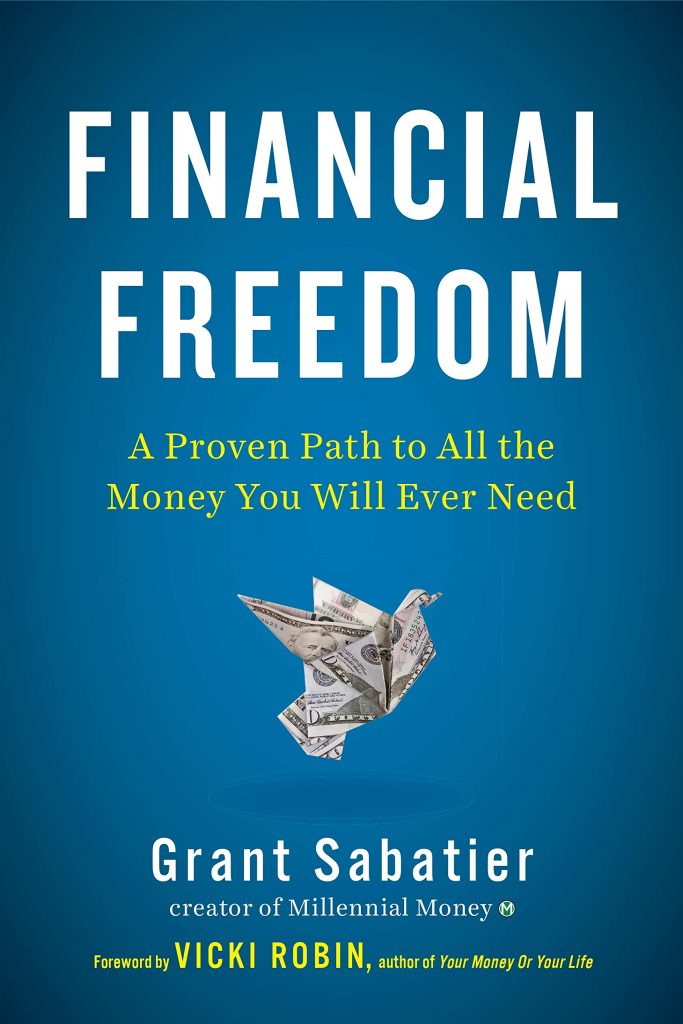This article has been reviewed by Sumeet Sinha, MBA (Emory University Goizueta Business School). Should you have any inquiries, please do not hesitate to contact at sumeet@finlightened.com.
In 2010, Grant Sabatier, the author of the book Financial Freedom, was struggling financially. He was unemployed, was living with his parents at age 24, and had just $2.26 in his bank account.
Thinking about his situation, and thinking broadly about wealth across generations, he realized that due to the wages not catching up with inflation, the millennials (compared to boomers) are struggling to save money. Add to that the additional burden of student loans, and the chances of saving money become even slimmer.
Grant Sabatier decided to take control of his finance and his life.
Financial Freedom By Grant Sabatier
Read also:
- 8 Steps To Financial Independence | Financial Freedom | Best Books List
- 10 Best Negotiation Tactics From Secrets Of Power Negotiating | Best Books List
- Atomic Habits Summary & 8 Key Takeaways | Best Books List
- 10 Best Credit Repair Books For DIY Credit Repair [2022]
- 4 Best Books On Personal Finance For Kids [2022]
- 16 Best Personal Finance Books For Teens And Young Adults [2022]
- 27 Best Personal Finance Books To Read
Steps To Financial Independence
In this article, we share our learnings from the book “Financial Freedom” and the easy-to-understand 8 Steps to Financial Independence.
1. Think Different
Grant Sabatier realized that he would have to do something different than just a 9-to-5 job if he ever wanted to accumulate wealth. He learned about finance, and developed a rare but crucial perspective on money – that money is not a finite resource, it’s just a tool to generate more wealth.
Grant Sabatier set himself a target of 1.25Million and built a plan that would involve working a full-time job, running two side hustles, and investing in the stock market.
By the year 2015, Grant had accumulated over a million dollars, in just 5 years.
Let’s take a look at the strategies used by him to get there.
2. Know Your Expenses
In order to set yourself a savings target, you need to know how much you spend every year. From there you can back-calculate to see how much you should save.
Grant Sabatier calculated his number to be $50,000 per year.
Everyone’s situation is different so this number will vary depending on location, lifestyle, future plans of adding family members, etc.
Grant then used the 4% rule to back-calculate the savings he would need to make 50,000 dollars every year.
The 4% rule is very commonly used by financial advisors to determine a withdrawal rate from retirement savings accounts. Money grows at about 7% on average, so with long-term inflation of about 3%, and withdrawal of 4%, the invested money stays the same, and you get to keep withdrawing in perpetuity.
So, according to the 4% rule, Grant would need 50,000 / 4% = 1,250,000
Bestseller Personal Finance Books
That became his savings target.
Sidenote: more recently the experts recommend a safe withdrawal rate of 3.3%, which will pump the number up, also the inflation in the past few months has been much higher so you could adjust for that as well, but for now but let’s keep moving with the story.
3. Compute Your Net Worth
As you begin your journey to financial freedom, your starting point should be to compute your net worth.
Computing net worth is easy.
First, calculate the monetary value of all the assets that you own – investments, savings, and fair market value of cash, car, house, and other belongings.
Then calculate the monetary value of all the liabilities that you have – outstanding credit card balance, student loan, car loan, mortgage, etc.
To compute the net worth, subtract the liabilities from your assets.
At this point, you might have a negative number. But don’t panic.
It’s a journey, and you are just getting started in the right direction.
Keep tracking your net worth from time to time.
4. Think About Money In Terms Of Time
To be more conscious about your spending habits, think of the expense in terms of time, rather than just dollars.
If you’re buying a $5 cup of coffee, try to compute the number of hours you spent to earn those $5.
In order to do that, you have to calculate your actual hourly income.
Let’s say you earn a gross amount of $15 per hour, you work 8 hours a day, spend another hour commuting to work, and another hour prepping for work – getting ready, ironing clothes, etc.
So, you spend 10 hours in a day on work and work-related activities and make 15*8 = $120 per day (you get paid only for 8 hours), so on average, you make $12 per hour (gross).
After taxes and deductions, let’s say you are left with $10 per hour.
So, the $5 coffee actually costs you 30 minutes of your work time!
How much of your time does the $100 impulse purchase cost you? What about the $1,000 phone?
You get the idea!
5. Save On Big 3 Expense Categories
When it comes to expenses, the average American household spends 60% of its income on housing, food, and transportation – the big 3 spend categories.
If a house spends about $35,000 here and can cut down 40-50% on their spending here, and invest the savings instead, it will create them a fortune in 30 years.
Assuming a 9% average rate of return, an annual investment of $15,000 will be worth $2.2 M in 30 years.
So, think about this – can you move to a cheaper home?
Can you drive a modest car or even get rid of the car and all associated costs such as gas, repairs, maintenance, insurance, etc.? Is public transport or car sharing an option for you? Think about it.
For food, you could look at how often you want to eat out. Can you buy food items in bulk to get a discount? OR some other creative ways to cut down the food category?
Be honest with yourself, there are no right or wrong answers here, but the fact remains that the more you save and invest, the sooner you will achieve your target.
If you can save 25% or more of your income every month, you’re doing great.
6. Optimize Your Workplace Benefits
Explore all benefits your workplace offers, starting with a 401(k) plan. If the employer offers a 401(k) match, make sure you contribute enough to get the maximum employer match you can get.
Negotiate a higher salary: Do some research to find out what is the salary offered in the market for similar job roles. Offer to take up some additional responsibilities, and ask for a raise at your workplace, say a 10% increase in your salary based on the market research and tasks you will perform.
Also, check if you can work fully or partially from home. Even if you get to work 2 days a week from home, you save on time, money, and the stress of a commute.
7. Start Side Hustle(s)
Set up a side business with the potential to turn it into a passive income stream.
Initially, you’ll have to use your free time to get the business started and lift it off the ground, but if the business scales up, you can hire others to run your business.
You can then invest your passive earnings into the investment account to reach your goal faster.
For starting your side hustle, research the competition and put in a small investment to test out the business idea. No matter how good the idea seems, do not put all your eggs in one basket. This way you will not burn yourself if your business idea fails.
8. Take The Plunge
Planning is great, but taking action is better. No matter how good a financial strategy is, if you don’t act on it, it is worth nothing.
So, acquire sufficient knowledge and do your planning, but don’t wait for the PERFECT plan and PERFECT timing – because that does not exist. Get started soon, and you will learn things along the way.
Taking the path less traveled is challenging, but it could buy you decades of freedom in the long run.
Final Words
Financial freedom has been much talked about, especially in recent years, by people working in cubicles a 9-to-5 job. This book shows the readers the way it can be achieved by having the right strategy in place and acting on it.
If implemented properly, there are just 8 steps to financial independence. Add some courage and patience to it, and you will be there!
Like the article? Consider grabbing the book “Financial Freedom” by Grant Sabatier.
Financial Freedom By Grant Sabatier
Read Also:
- 10 Best Negotiation Tactics From Secrets Of Power Negotiating | Best Books List
- Atomic Habits Summary & 8 Key Takeaways | Best Books List
- 5 Best Pay As You Go Websites
- 10 Best Credit Repair Books For DIY Credit Repair
- 4 Best Books On Personal Finance For Kids
- 16 Best Personal Finance Books For Teens And Young Adults
- 27 Best Personal Finance Books
- 19 Best Personal Finance Reddit Communities You Should Join
- 19 Best Reddit Personal Finance Tips on r/PersonalFinance Threads
- Personal Finance Flowchart: 3 Helpful Ones For Beginners and Advanced Levels
- Are Americans Good at Personal Finance? 5 Facts on Personal Finance
- Beginner’s Guide to Personal Finance: 10 Steps To Manage Money Better
- 8 Cool Benefits of Obtaining A Personal Loan – When to Consider It?
- How to Build a Budget and Stick to It [Plus 4 Best Budgeting Apps]
- How to Use Credit Card Responsibly: 7 Must-Have Credit Habits


Read more
Popular Topics: Stocks, ETFs, Mutual Funds, Bitcoins, Alternative Investing, Dividends, Stock Options, Credit Cards
Posts by Category: Cash Flow | Credit Cards | Debt Management | General | Invest | Mini Blogs | Insurance & Risk Mgmt | Stock Market Today | Stock Options Trading | Technology
Useful Tools
Student Loan Payoff Calculator | Mortgage Payoff Calculator | CAGR Calculator | Reverse CAGR Calculator | NPV Calculator | IRR Calculator | SIP Calculator | Future Value of Annuity Calculator
Home | Blog
Our Financial Calculator Apps
Page Contents
















